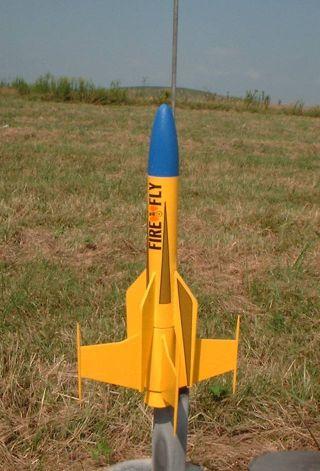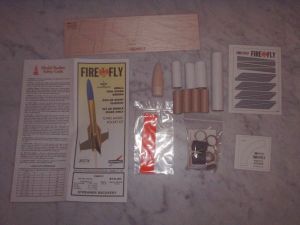| Construction Rating: | starstarstarstar_borderstar_border |
| Flight Rating: | starstarstarstarstar_border |
| Overall Rating: | starstarstarstarstar_border |
| Diameter: | 0.91 inches |
| Length: | 9.00 inches |
| Manufacturer: | Semroc  |
| Skill Level: | 2 |
| Style: | Multi-Stage |

Brief:
Semroc brings back another Centuri classic with this one, hailed as the world's
smallest two-stage rocket in it's heyday around 1968. Faithfully reproduced
right down to the original tube sizes, this kit will be a fun build for the
nostalgia buff, though modern day flights will prove problematic.
Construction:
The kit for this review was graciously provided by
BRS
Hobbies. It arrived carefully packaged and in good shape. Most Semroc kits
come with a neat little ID tag showing the production unit number, mine was
#177. Semroc kits use excellent quality materials throughout.
Parts list includes:
- 1 ST-8 body tube 4.5"
- 1 ST-8 body tube 2.0"
- 2 ST-7 body tubes 2.0"
- 1 BC-821 balsa nose cone, with washer/screw eye for weight
- Laser cut balsa fins (2 sets of 4 fins each)
- Assorted couplers and centering rings
- Paper shroud (from pattern)
- Wood "dowels" for trim
- 36" plastic streamer
- Kevlar®/elastic shock cord
- 4 adapter tubes for motors
- water slide decals
The instructions were well illustrated and generally well done, although I ran into some difficulty in the fit, which could either mean my goof in not carefully paying attention to a measurement or something gone awry with the kit. I have not had any trouble with other Semroc kits so I will assume I'm a klutz, but would love to see some feedback from other builders on this.
 Construction
begins by sanding and trimming the fins from the laser cut sheet. Though there
are 8 fins, this is a small rocket, and sanding really didn't take much more
than 10 minutes with 180 grit and a light rub or two with 400 grit. I normally
also apply either a couple coats of balsa sealer/grain filler or a light coat
of Elmer's Fill 'n' Finish at this point but decided to cut a few minutes off
the build time to get this one out on the pad as quickly as possible.
Construction
begins by sanding and trimming the fins from the laser cut sheet. Though there
are 8 fins, this is a small rocket, and sanding really didn't take much more
than 10 minutes with 180 grit and a light rub or two with 400 grit. I normally
also apply either a couple coats of balsa sealer/grain filler or a light coat
of Elmer's Fill 'n' Finish at this point but decided to cut a few minutes off
the build time to get this one out on the pad as quickly as possible.
The booster mount is a little unusual, presumably the way they did things back in 1968 (when I would have been too young to fly). The engine block goes on the AFT end of the motor tube, and a coupler with vent hole goes on the forward end. A couple of centering rings are then tacked on. While waiting for that to dry, the 2" booster body tube gets a coupler glued into the forward end. To complete the assembly, the motor tube is glued into the booster body tube/coupler assembly. After looking it over closely, I can't think of a reason for the inner coupler to be vented, as the outer coupler is not.
The booster is then completed by attaching the fins and toothpick trim, along with a paper shroud. It was at this point that I started to sense that this rocket was more for show than for actual flight, as the toothpicks are just begging to break on even a soft landing and the paper shroud is not going to hold up to repeated flights on even a 1/4A motor. I lined the inside of mine with a thin CA for strength to hopefully delay the burn through.
The sustainer construction follows a similar construction path, starting with engine block going into the forward end of the motor tube, which also anchors a Kevlar® shock cord--a nice upgrade. Centering rings are added, then the assembly is glued into the sustainer body tube. Tack on the fins and a launch lug, and you're done.
I test fit the booster to the sustainer, and ran into a fairly significant problem. While the dimensions seemed right for the coupler between the booster and sustainer, the inner coupler with the vent hole won't slip inside or over the motor tube in the sustainer, so I could not get the two assemblies to join together. I wound up having to cut away most of the inner coupler, which was not exactly easy with everything already glued into place. Again, probably my error, but I would recommend a dry fit before gluing either motor mount assembly into their respective body tubes.
One other aspect of the fit I found unusual, although clearly on purpose and part of the design, is that the booster and sustainer fins are not interlocking or even separated enough to be on the same plane. The sustainer fins extend well below the bottom and slip over the booster body, so they need to be rotated/positioned to sit between the booster fins. The result is an 8-fin profile and a significant increase in drag. It looks neat, but I'm personally more of a fan of the interlocking fin approach.
Finishing:
I followed the standard paint scheme on this, going for a yellow base coat on
the body and a blue nose cone. I went with Krylon primer and top coats and
finished it off with a clear coat, which I applied before the decals rather
than after. (I know this is backwards, but I never seem to get consistent
results over decals).
The waterslide decals were fairly good quality, but my kit had what appeared to be an error on the accent trim for the sustainer fins. I had 8 decals all the same pattern, which fit great on one side of the fins, but don't fit at all on the opposite side. I suspect that 4 of these were supposed to be inverse orientation.
Construction Rating: 3 out of 5
Flight:
Given that the Estes A10-0T is no longer certified for use by the NAR, flights
for this kit are problematic. The package header card describes "two-stage
design" and "out of sight flights", even though it warns to fly
as single stage only and recommends only a 1/2A3-4T motor and estimated
altitude of 225 feet.
The original kit was designed to fly on 1/2A-6 "shorty" motors, which I believe were 18mm but only 1.75" long. This kit holds true to that scale, using 18mm motor mounts but between the two stages there's only 3.5" of room--too much for a single 18mm and too short for staging with 2. The solution offered up is an adaptor tube that's 13mm ID/18mm OD by 1.75" long. There are 4 provided in the kit, and the instructions suggest gluing a mini motor into an adaptor tube for flight.
I have two big problems with this approach: First, this is not a reusable approach. So unless you've got a supply of 13/18mm tube adaptors, you're only going to get a couple of flights out of this. (I would suggest that you start hanging on to your spent 18mm motors, as they can be cleaned out and cut down to make adapters.) The second problem is that there simply aren't two motors that can be used today to fly this, meaning you have to leave the booster behind when you go to the pad. So why bother even building it, other than for display?
My workaround to this was to use an 18mm 1/2A6-2, with a creative tape job to secure it in the booster, and to tape the two stages together so that there would be no separation. That worked fine, as I got a perfectly straight up flight, though closer to 75 feet than 225, so the 225 estimate must clearly be for the sustainer only.
Recovery:
The streamer deployed without a hitch. Just as I feared though, I broke one of
the toothpicks upon impact, despite a fairly slow descent rate and landing on
tall, soft grass. I'm not sure if this would be helped or hurt by tumble
recovery without the sustainer attached, and will try again when I'm flying a
non-NAR launch with an old A10-0T.
Despite the flawless flight, I'm only rating this a 4 out of 5 due to the problems adopting modern motor availability to the classic design and would much prefer either an upscale to twin 18mm motors or simply going down to 13mm and not fussing with the shorty adapters.
Flight Rating: 4 out of 5
Summary:
If you're a nostalgia buff and want to build a cute little design to sit on
display, this rates a 5. If you like to fly what you build, you're going to
have trouble with this and it would be closer to a 3. This kit just doesn't
work out that problem very well.
Still, it's a very nice looking design faithfully reproduced in great detail. If Estes ever abandons the race cars and switches back from A10-PTs to A10-0Ts, this would be a smokin' little two-stager.
Overall Rating: 4 out of 5
 |
 |
Flights
 |
 |
B.B. (September 4, 2004)
Sponsored Ads
 |
 |












D.W.G. (September 2, 2004)